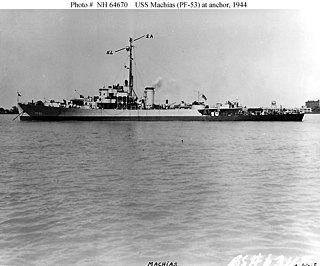
USS St. George (CVE-17) was laid down on 31 July 1941 as a C3-S-A2 by Ingalls Shipbuilding, Hull 296 of Pascagoula, Mississippi, under Maritime Commission contract as the (second) SS Mormacland for Moore-McCormack Lines, Inc.,. She was renamed St. George (AVG-17) by the United States Navy on 7 January 1942; and assigned to the United Kingdom under Lend-Lease as HMS Pursuer on 24 February 1942. The vessel was launched on 18 July 1942, sponsored by Mrs. Mary Ann S. Bartman. The escort carrier was reclassified ACV-17 on 20 August 1942, acquired by the US Navy and simultaneously transferred to Britain on 14 June 1943. She was reclassified CVE-17 on 15 July 1943.

Landing craft are small and medium seagoing watercraft, such as boats and barges, used to convey a landing force from the sea to the shore during an amphibious assault. The term excludes landing ships, which are larger. Production of landing craft peaked during World War II, with a significant number of different designs produced in large quantities by the United Kingdom and United States.

A dock landing ship is an amphibious warfare ship with a well dock to transport and launch landing craft and amphibious vehicles. Some ships with well decks, such as the Soviet Ivan Rogov class, also have bow doors to enable them to deliver vehicles directly onto a beach. Modern dock landing ships also operate helicopters.

HMS Tracker (BACV-6/D24) was an Attacker-class escort carrier that was built in the United States, but served in the Royal Navy during World War II.

The Landing Craft, Tank (LCT) was an amphibious assault craft for landing tanks on beachheads. They were initially developed by the Royal Navy and later by the United States Navy during World War II in a series of versions. Initially known as the "tank landing craft" (TLC) by the British, they later adopted the U.S. nomenclature "landing craft, tank" (LCT). The United States continued to build LCTs post-war, and used them under different designations in the Korean and Vietnam Wars.

A landing ship, tank, (LST) is a ship first developed during World War II (1939–1945) to support amphibious operations by carrying tanks, vehicles, cargo, and landing troops directly onto a low-slope beach with no docks or piers. The shallow draft and bow doors and ramps enabled amphibious assaults on almost any beach.

A infantry landing ship was one of a number of types of British Commonwealth vessels used to transport landing craft and troops engaged in amphibious warfare during the Second World War. LSIs were operated by the Royal Navy, British Merchant Navy, Royal Canadian Navy, Royal Indian Navy, and Royal Australian Navy. They transported British Commonwealth and other Allied troops in sea assaults and invasions throughout the war.

Empire Battleaxe was a British ship of the Second World War and as HMS Donovan in service with the Royal Navy just after the Second World War. Built as a Type C1-S-AY1 Landing Ship, Infantry named Cape Berkeley she then saw merchant service as Empire Battleaxe before being commissioned into the Royal Navy as HMS Empire Battleaxe and then Donovan. After she was decommissioned she returned to merchant service as Empire Battleaxe and was returned to the USA where she was renamed Cape Berkeley once again. A proposed sale in 1948 to China and renaming to Hai C fell through and she was scrapped in 1966.

An amphibious assault ship is a type of warship employed to land and support ground forces on enemy territory during an armed conflict. The design evolved from aircraft carriers converted for use as helicopter carriers. Modern designs support amphibious landing craft, with most designs including a well deck. Like the aircraft carriers they were developed from, some amphibious assault ships also support V/STOL fixed-wing aircraft and have a secondary role as aircraft carriers.

USS White Marsh (LSD-8) was an Ashland-class dock landing ship of the United States Navy, named in honor of White Marsh, Virginia, the birthplace of Walter Reed (1851–1902).

USS Casa Grande (LSD-13) was a Casa Grande-class dock landing ship of the United States Navy, named in honor of Casa Grande Ruins National Monument near Coolidge, Arizona.

USS Rushmore (LSD-14) was a Casa Grande-class dock landing ship of the United States Navy. She was named in honor of Mount Rushmore National Memorial in the Black Hills of South Dakota.

An amphibious warfare ship is an amphibious vehicle warship employed to land and support ground forces, such as marines, on enemy territory during an amphibious assault.
HMS Sansovino was an infantry landing ship in service with the Royal Navy during the late stages of the Second World War.
Two ships of the British Royal Navy have been named HMS Dagger after the weapon:

The second USS Machias (PF-53) was a United States Navy Tacoma-class frigate in commission from 1944 to 1945 which later served in the Soviet Navy as EK-4 and the Japan Maritime Self-Defense Force as JDS Nara (PF-2), JDS Nara (PF-282) and YTE-8.

The Ashland-class dock landing ship were the first class of dock landing ship of the United States Navy. They were built during World War II. A dock landing ship is a form of auxiliary warship designed to support amphibious operations. Eight ships were built for the United States Navy and they remained in US service until the 1960s. Two of the class were sold for export overseas, with one joining the Republic of China Navy and the other the Argentinian Navy. The two transferred ships stayed in service until the 1980s. All eight ships were scrapped.
HMS Dakins (K550) was a Captain-class frigate of the Royal Navy during the Second World War. Built as the Buckley-class destroyer escort DE-85 intended for the United States Navy, she was transferred to the Royal Navy in 1943 under the terms of Lend-Lease.














